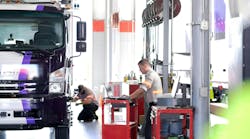LAS VEGAS. While fleets in other trucking segments focus on fuel economy or price as their top concern when buying equipment, the typical construction truck buyer focuses more on vehicle specs, according to industry suppliers interviewed here at the ConExpo-Con/Agg show.
“The number one goal of the construction truck buyer is that they want a truck spec’d right for the job,” Stephan Olsen, director of vocational product marketing for Kenworth Trucks, told Fleet Owner. “They want to make sure they have the right axle capacity, frame rail strength, suspension package, transmission, rear axle ratio, etc., so that truck can handle the job it’s expected to without problems.”
Everything else, from lower maintenance vehicles to improved fuel economy, flows from those spec’ing decisions.
“Reducing vehicle downtime due to road calls and maintenance work relates to spec’ing it right so it’s reliable,” he said. “Building a lighter weight truck that can haul more payload or one that has more engine power or better fuel economy all relates to how it’s spec’d. That’s why they focus so closely on the initial spec’ing decisions in this market.”
Fred Klotz, president of Klotz Equipment Company, which manufactures concrete mixer packages, added that properly spec’ing construction trucks is also critical to making it hold up over its expected life cycle.
“Everyone says this industry turns over trucks every five years. It’s not true; they still push them out a lot longer than that,” he told Fleet Owner. “That’s why you have to design it right from the start. For example, we use a bigger roller on our mixer drum so it will last longer. A 40 to 50-unit fleet using our mixers may need to replace 10 rollers in a year, while a 15-unit fleet with mixers using smaller rollers will replace the same 10 rollers as well in a year – but that’s a much higher maintenance cost for them.”
Chassis strength is also critical and Klotz believes it’s a subject that’s not getting enough attention. “Customers will come to me with bent chassis frames and cracked mixer drum supports and ask why it’s happening,” he said. “It’s simple: the chassis they are using isn’t strong enough to haul the payload they are carrying. You have to be very careful when selecting that chassis – you have to have the proper crossmembers on the chassis to support the load you expect to carry or you’re going to have problems.”


